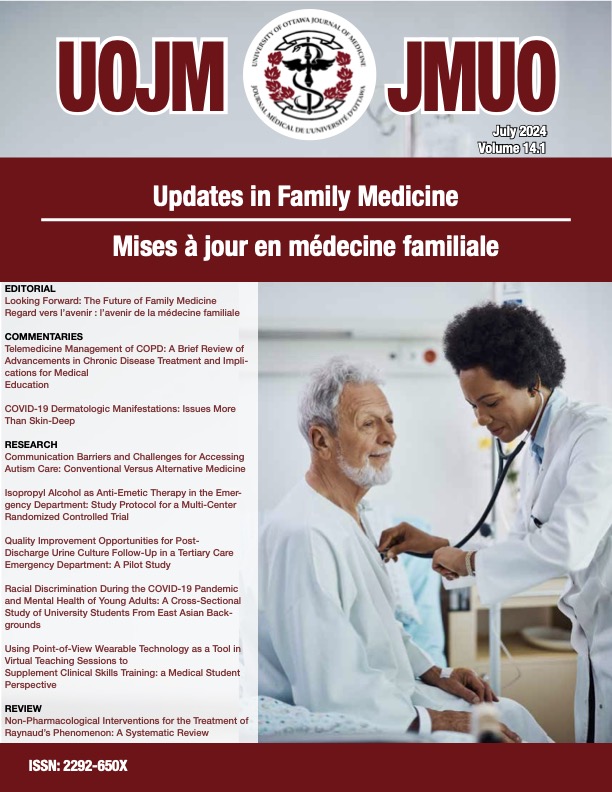Isopropyl alcohol as anti-emetic therapy in the emergency department: study protocol for a multi-center randomized controlled trial
DOI :
https://doi.org/10.18192/uojm.v13i1.6100Mots-clés :
emergency department; isopropyl alcohol; inhalation; nausea; vomitingRésumé
Background: Nausea and vomiting is a common and distressing presenting complaint in Emergency Departments (EDs). There is no definite evidence to support the superiority of any anti-emetic therapy over another, or over placebo. Identification of an effective anti-emetic therapy in the ED setting with minimal side effects would be of great benefit. Isopropyl alcohol inhalation has been reported to be an effective treatment for post-operative nausea and vomiting, with no reported adverse events. The objective of this study is to determine if nasally inhaled isopropyl alcohol swabs are effective in alleviating nausea and/or vomiting in patients presenting to the ED with a chief complaint of nausea and/or vomiting.
Methods: We will conduct a randomized, controlled, multicenter trial with three subject arms: 1) nasally inhaled isopropyl alcohol swabs every 10 minutes for a total of one hour, 2) nasally inhaled isopropyl alcohol swabs every 20 minutes for a total of one hour, or 3) no intervention. 135 participants ≥18 years old and presenting to the ED with a chief complaint of nausea and/or vomiting with a level of 3 or greater on a verbal numeric rating scale (NRS) will be recruited for a duration of two hours. The primary outcome measure is the mean reduction in nausea scores comparing the pre-intervention score to the lowest post-intervention nausea score. The secondary outcome measures will be participant satisfaction scores using a verbal NRS, receipt of any rescue anti-emetic medications, ED length of stay, and participant disposition (admission or discharge home).
Discussion: This study will determine the efficacy of inhaled isopropyl alcohol swabs by determining the optimal dosing frequency achieving adequate anti-emetic action. This has the potential to guide future triage protocols to incorporate this therapy to provide earlier symptomatic relief to patients, and also has the potential to prevent morbidity suffered by patients in the emergency department and improving patient satisfaction and efficiently use in-patient resources. We strongly suspect that once this study is performed, it will be useful for ED physicians in treating nausea and vomiting in the ED.
Téléchargements
Publié-e
Numéro
Rubrique
Licence
© Alexandra Hamelin , Ali Shahbaz Syed, Venkatesh Thiruganasambandamoorthy 2024

Cette œuvre est sous licence Creative Commons Attribution - Pas d'Utilisation Commerciale - Pas de Modification 4.0 International.
- Les auteurs qui publient dans le JMUO gardent les droits d’auteur de leurs articles, incluant tous les brouillons et la copie finale publiée dans le journal
- Bien que le JMUO n’a pas les droits d’auteur des articles soumis, en acceptant de publier dans le JMUO, les auteurs donnent le droit au journal d’être les premiers à publier et à distribuer leurs articles.
- Par la suite, les auteurs peuvent soumettre leurs documents à d’autres publications, incluant des revues ou des livres, avec un remerciement de leur première publication dans le JMUO
- Des copies du JMUO seront distribuées à la fois sous format papier et en ligne, et tous les matériaux seront accessibles au public en ligne. Le journal n’a pas de responsabilité légale par rapport à la distribution publique du contenu.
- Prière de vous assurer que tous les auteurs, les coauteurs et les investigateurs
- Le contenu est rendu disponible sous licence Creative Commons Attribution - Pas d'Utilisation Commerciale - Pas de Modification 4.0 International.


